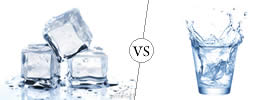Difference between Rum and Brandy
Key Difference: Rums are distilled alcoholic beverages made from sugarcane byproducts such as molasses or sugarcane juices. Similar to most alcoholic beverages, rums must go through the process of distillation, fermentation and aging. Brandy, short for brandywine is a sprit that is distilled from wine, grapes and other fruit juices. The word ‘brandywine’ is derived from the Dutch word ‘brandewijn’ meaning “burnt wine”. Brandies are more commonly considered as an after-dinner drink and can contain alcohol by volume (ABV) between 35% and 60%.
Rum and Brandy are two different types of drinks that are available in the market. They differ from each other in many ways and should not be confused as the same. They are made using different ingredients as well as different processes. However, similar processes between both include fermentation and distillation.
 Rums are distilled alcoholic beverages made from sugarcane byproducts such as molasses or sugarcane juices. Similar to most alcoholic beverages, rums must go through the process of distillation, fermentation and aging. Depending on the geographical region of the product, rums differ in taste, color and strength. The origin of the term ‘rum’ is unclear and there are various different possibilities as to how the name came by. British etymologist, Samuel Morewood in his 1824 essay stated that the word ‘rum’ was a British slang term from “the best”. Morewood also suggested another possibility that the word was taken from the last syllable of the Latin word, “saccharum”, meaning “sugar”. Other possibilities include the word being derived from other popular British drinks of the time such as ramboozle and rumfustian.
Rums are distilled alcoholic beverages made from sugarcane byproducts such as molasses or sugarcane juices. Similar to most alcoholic beverages, rums must go through the process of distillation, fermentation and aging. Depending on the geographical region of the product, rums differ in taste, color and strength. The origin of the term ‘rum’ is unclear and there are various different possibilities as to how the name came by. British etymologist, Samuel Morewood in his 1824 essay stated that the word ‘rum’ was a British slang term from “the best”. Morewood also suggested another possibility that the word was taken from the last syllable of the Latin word, “saccharum”, meaning “sugar”. Other possibilities include the word being derived from other popular British drinks of the time such as ramboozle and rumfustian.
Majority of the rum in the world is produced in the Caribbean and Latin America, with selected other countries such as India, Spain, New Zealand, Mexico, etc. also partaking in producing the beverage. Rum was first distilled on a sugarcane plantation in the Caribbean during the 17th century. The slaves at the plantation discovered that molasses, a byproduct of sugarcane when it is refined into suger, could be fermented into alcohol. Other places to record early rum distillation include Brazil and Barbados. After the development of rum, it grew fast in demand and it was also used in many places as currency. To support the increasing demand of sugar, labor was required to work the sugar plantations. This resulted in the establishment of the triangular trade between Africa, the Caribbean and the European colonies. Rum also became popular with seamen and pirates.
Rum does not have any set production methods, with the methods varying depending on the region where the distillers are located. Similar to some other alcoholic beverages, rum goes through the process of fermentation of either molasses or sugarcane juice. During fermentation, the water and yeast is added to the base ingredient, allowing the yeast to break down the sugar. Depending on the type of yeast used for fermentation, the taste and aroma of the rum varies. After distillation, the rum is then put through the process of distillation. After distillation, the rum is required to be aged for at least one year in many countries. The aging process could be done in wooden casks (natural or charred) as well as in stainless steel tanks. The rum in the wooden casks is darker in appearance, while the rum in stainless steel tanks remains colorless. Caramel can also be added to rum to adjust the color of the final product before it is bottled.
According to Wikipedia, rum comes in certain grades and variations. They can be classified under the following:
- Light rums: Light rums are rums that are light or clear in color. They can also be referred to as white rum. They have very little flavor and are used in cocktails.
- Gold rums: Gold rums are also known as amber rums. They are often aged in charred white oak barrels. They have a stronger flavor compared to light rums.
- Dark rums: These are darker in color such as black, red or brown. They are aged for a longer period of time in heavily charred barrels. They may also have a hint of spices and caramel to adjust the color and flavoring. They are stronger and sweeter compared to the light and gold rums.
- Spiced rums: These rums obtain the flavor from spices or caramel. They are dark in color and may have spices such as cinnamon, rosemary, absinthe/aniseed, or pepper.
- Flavored rums: These rums are infused with additional flavors such as banana, coconut, citrus, etc.
- Overproof rums: These rums are higher in proof and ABV.
- Premium rums: These rums are high priced and are carefully aged and produced. They are said to have more flavor and taste.
.jpg) Brandy, short for brandywine is a sprit that is distilled from wine, grapes and other fruit juices. The word ‘brandywine’ is derived from the Dutch word ‘brandewijn’ meaning “burnt wine”. Brandies are more commonly considered as an after-dinner drink and can contain alcohol by volume (ABV) between 35% and 60%. The origins of brandy can be dated back to the development of distillation to ancient Greece and Rome. However, modern brandy can be dated back to the 12th century. Brandies are made using grapes or any fruits that can produce a sugary juice. According to Encyclopaedia Britannica, brandy can also be used to refer to spirit made from pomace and other fermented fruit. However, if the brandy is made from any other fruit instead of grapes, many countries require it to be labeled as ‘fruit brandy’, ‘fruit spirit’, or the name of the fruit should be mentioned on the bottle. The regulations for producing and labeling differ depending on the jurisdiction.
Brandy, short for brandywine is a sprit that is distilled from wine, grapes and other fruit juices. The word ‘brandywine’ is derived from the Dutch word ‘brandewijn’ meaning “burnt wine”. Brandies are more commonly considered as an after-dinner drink and can contain alcohol by volume (ABV) between 35% and 60%. The origins of brandy can be dated back to the development of distillation to ancient Greece and Rome. However, modern brandy can be dated back to the 12th century. Brandies are made using grapes or any fruits that can produce a sugary juice. According to Encyclopaedia Britannica, brandy can also be used to refer to spirit made from pomace and other fermented fruit. However, if the brandy is made from any other fruit instead of grapes, many countries require it to be labeled as ‘fruit brandy’, ‘fruit spirit’, or the name of the fruit should be mentioned on the bottle. The regulations for producing and labeling differ depending on the jurisdiction.
The process of producing brandy requires fermenting the wine, fruit juice or grapes for 4-5 days after which they are distilled, using either pot-stills or column-still, before they are put into casks for aging. There is no set time required for aging as some fruit juices do not require aging. The aging process determines the color of the brandy; if it is not aged the brandy is colorless or clear and the longer it is aged the stronger the color of the brandy. Some brandy may also be added with caramel to adjust the color and the flavor of the beverage. Distillation must differ depending on the type of brandy being produced. For example, wine with ABV 8% to 12% and high acidity is boiled in a pot still. Brandy made from grapes also requires being distilled twice or more to acquire the required aroma and flavor.
Brandy is labeled in a certain way that shows the quality of the brandy. Labels include A.C. (aged 2 years), V.S. (very special, aged 3 years), V.S.O.P. (Very Superior Old Pale, aged at least 5 years), X.O. (Extra Old, aged at least 6 years), Vintage (the label shows the date it was placed into the cask) and Hors d'age (Too old to determine age, commonly more than 10 years). Other names for brandy include cognac and Armagnac, named after the place they were produced.
In a nutshell, rums are made using molasses or sugarcane juice, while brandy can be made using any type of fruit or even wine. Brandy is more of an after dinner-drink, while rums are often consumed as alcoholic beverages during parties. Rum has had a more significant impact on the society with at one time being used as currency. Both rums and brandies are available in different flavors. Rum and brandy both can be used in cooking, while brandy is also used for medicinal purposes.
Image Courtesy: frazierswine.co.uk
Image Courtesy: euvs.org









Add new comment